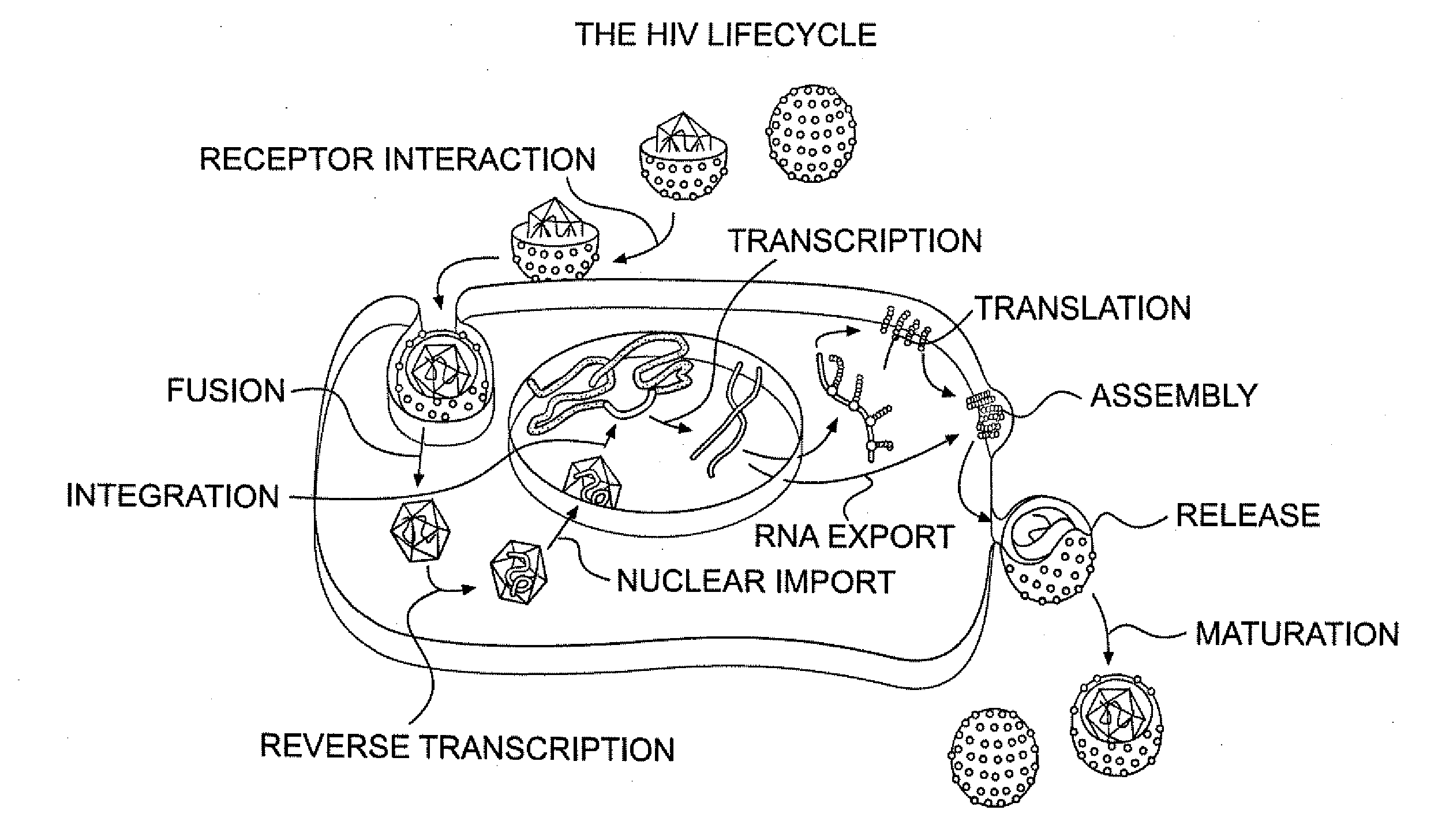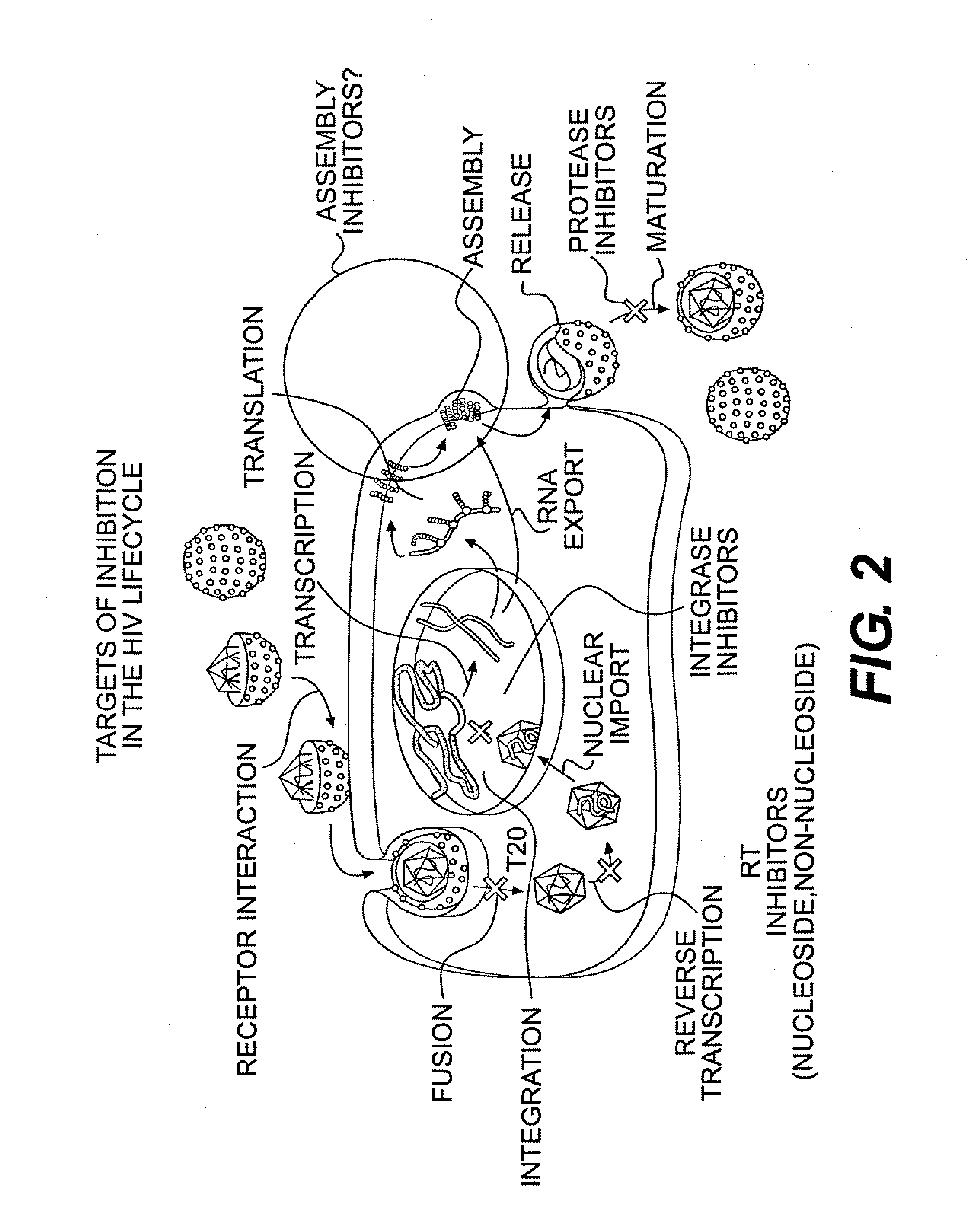Small molecule inhibitors of hiv-1 capsid assembly
a technology of capsid and small molecule, applied in the field of mammals' methods of treating hiv infections, can solve the problems of leaving them immature and non-infectious, and achieve the effect of being useful in the treatmen
- Summary
- Abstract
- Description
- Claims
- Application Information
AI Technical Summary
Benefits of technology
Problems solved by technology
Method used
Image
Examples
example 1
Compound Screening and Capsid Assembly
[0110]Compounds. A library of 10,000 drug-like molecules, which a molecular weight is less than or equal to 500 Da, five or fewer H-bond donors, ten or fewer H-bond acceptors, and a calculated log p [octanol / water partition coefficient] less than or equal to 5, was purchased from ChemBridge Corp. (San Diego, Calif.). The average molecular weight was 347 Da (200-596 Da) and was used for subsequent calculations of concentration unless otherwise indicated. The compounds came plated in 96-well plates and solubilized in DMSO at 5 mgs / mL. One or more of the following reagents were used as reference anti-HIV compounds in cell based assays: Indinavir Sulfate, a protease inhibitor was obtained from the NIH AIDS Research and Reference Reagent Program. The following were used as anti-CA HIV compounds: CAP-1 (N-(3-chloro-4-methylphenyl)-N′-{2-[({5-[(dimethylamino)-methyl]-2-furyl}-methyl)-sulfanyl]-ethyl}urea) compound and DSB (3-O-{3′,3′-dimethylsuccinyl}-...
example 2
HTS Assay
[0114]Recombinant CA protein was purified as previously described and stored at 300 μM at −80° C. A turbidity based assembly assay, described above, was adapted to a 96-well, microplate format to allow for medium-throughput screening of compounds in a Nepheloskan Ascent plate reader (Thermo Electron Corp., UK). A 1.5 μL aliquot of compound or DMSO was diluted 90-fold into 50 mM Na2HPO4, 2.25 M NaCl buffer, pH 8 in an optically clear 96-well plate. To initiate the assembly reaction, 15 μL of the 300 μM stock (in 50 mM Na2HPO4 pH 8) of recombinant HIV-1 capsid protein (CA), was added to each well of the 96-well plate using a multi-channel pipettor. The final average compound concentration was nominally 142 μM, the CA concentration was 30 μM, and the NaCl concentration was 2.25 M. The compounds were evaluated for their ability to decrease the rate of assembly as monitored by turbidity and scored by eye into strongly inhibitory, moderately inhibitory, or weakly inhibitory class...
example 3
In Vitro Studies
[0116]Cells and Viruses. HEK-293, a human embryonic kidney cell line and TZM-b1, a HeLa based cell line, were maintained in DMEM medium supplemented with 10% (vol / vol) heat-inactivated fetal bovine serum (FBS), 100 U / ml penicillin, 100 μg / ml of streptomycin and 292 μg / ml of L-glutamine. 5.25.GFP.Luc.M7 cells (Luc-M7), a CEM×174 based cell line, were maintained in RPMI 1640 containing 10% (vol / vol) FBS, 100 U / ml penicillin, 100 μg / ml of streptomycin, 292 μg / ml of L-glutamine, 1% Hepes, 0.5 μg / ml puromycin, 0.3 mg / ml geneticin (G418) and 200 μg / ml hygromycin B. Human peripheral blood mononuclear cells (PBMCs) were obtained from healthy donors and isolated by the Ficoll-Hypaque technique. HIV-1NL43 and HIV-1YU2 were prepared by transient transfection of 293T cells with pNL43 and pYU2, respectively, using FuGene 6 (Roche) and collecting the viral supernatant 48-72 hours post transfection.
[0117]Anti-HIV Assays (Multiple Round). The inhibitory effects of the tested compoun...
PUM
| Property | Measurement | Unit |
|---|---|---|
| diameter | aaaaa | aaaaa |
| diameter | aaaaa | aaaaa |
| molecular weight | aaaaa | aaaaa |
Abstract
Description
Claims
Application Information
 Login to View More
Login to View More - R&D
- Intellectual Property
- Life Sciences
- Materials
- Tech Scout
- Unparalleled Data Quality
- Higher Quality Content
- 60% Fewer Hallucinations
Browse by: Latest US Patents, China's latest patents, Technical Efficacy Thesaurus, Application Domain, Technology Topic, Popular Technical Reports.
© 2025 PatSnap. All rights reserved.Legal|Privacy policy|Modern Slavery Act Transparency Statement|Sitemap|About US| Contact US: help@patsnap.com



